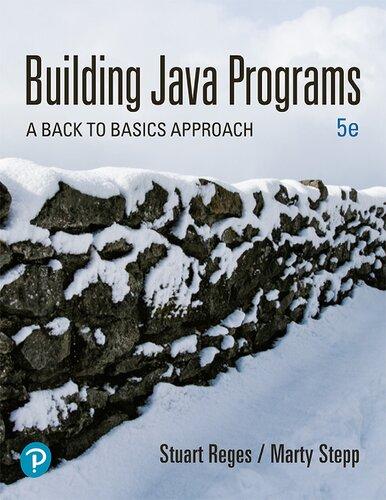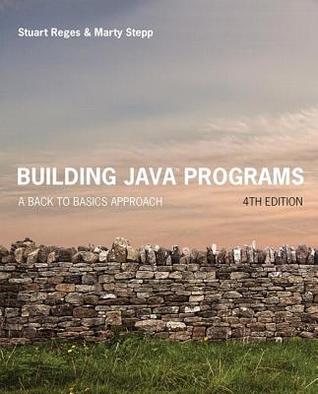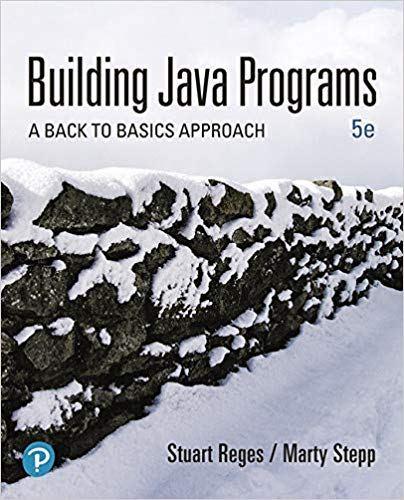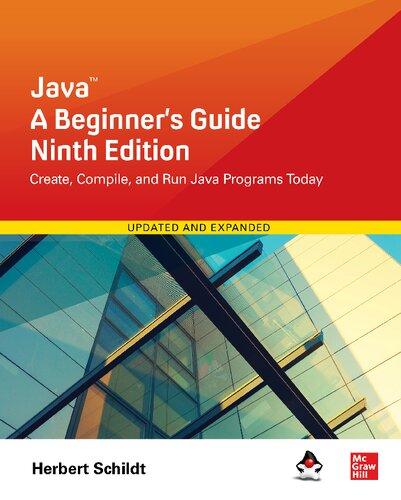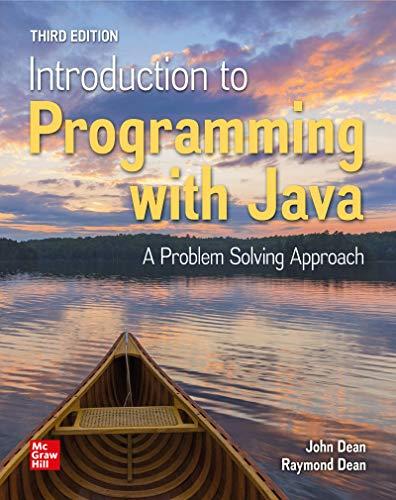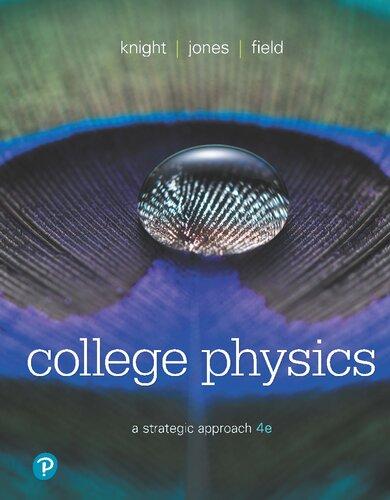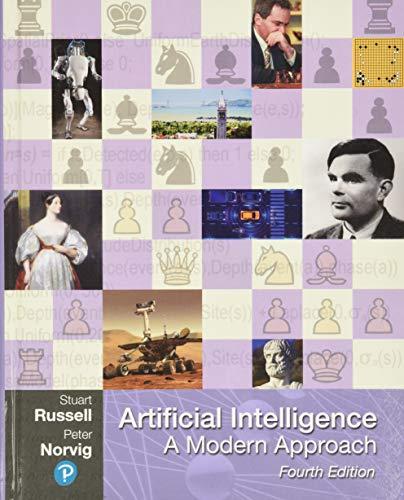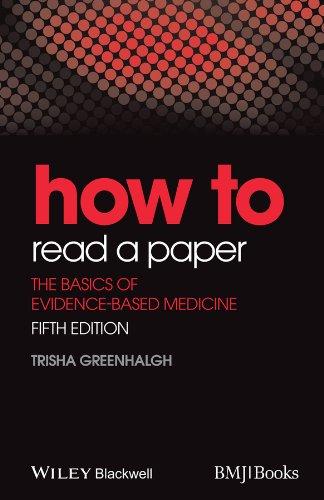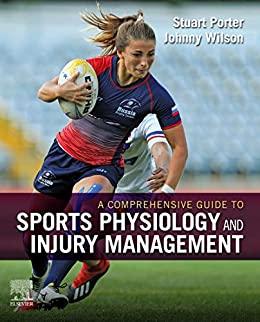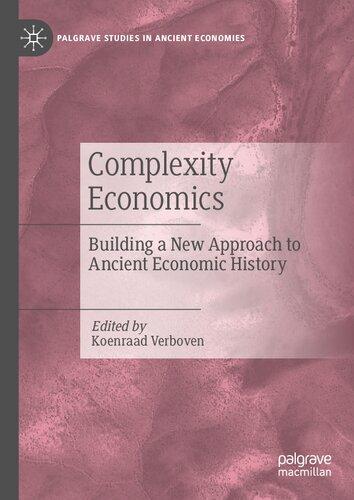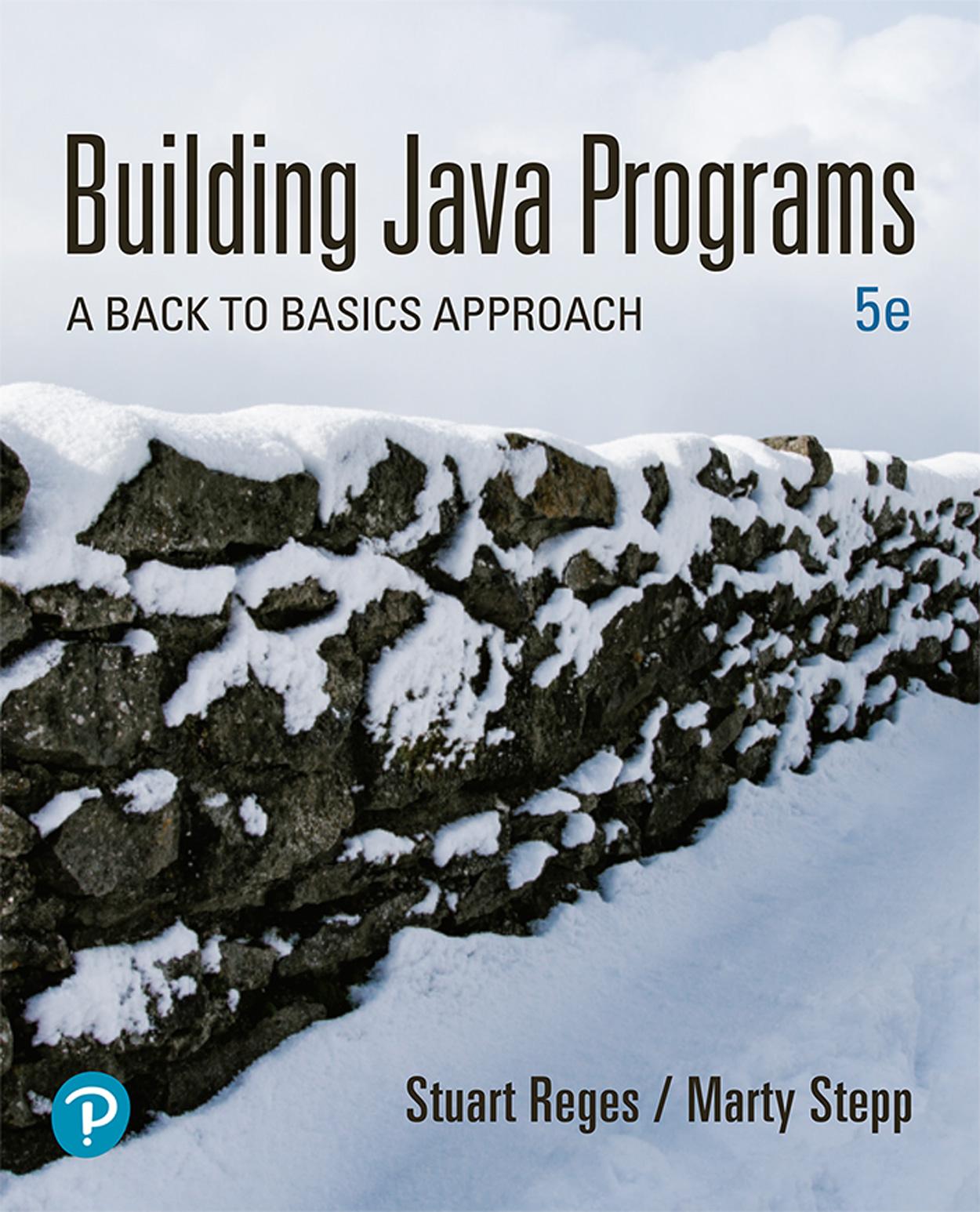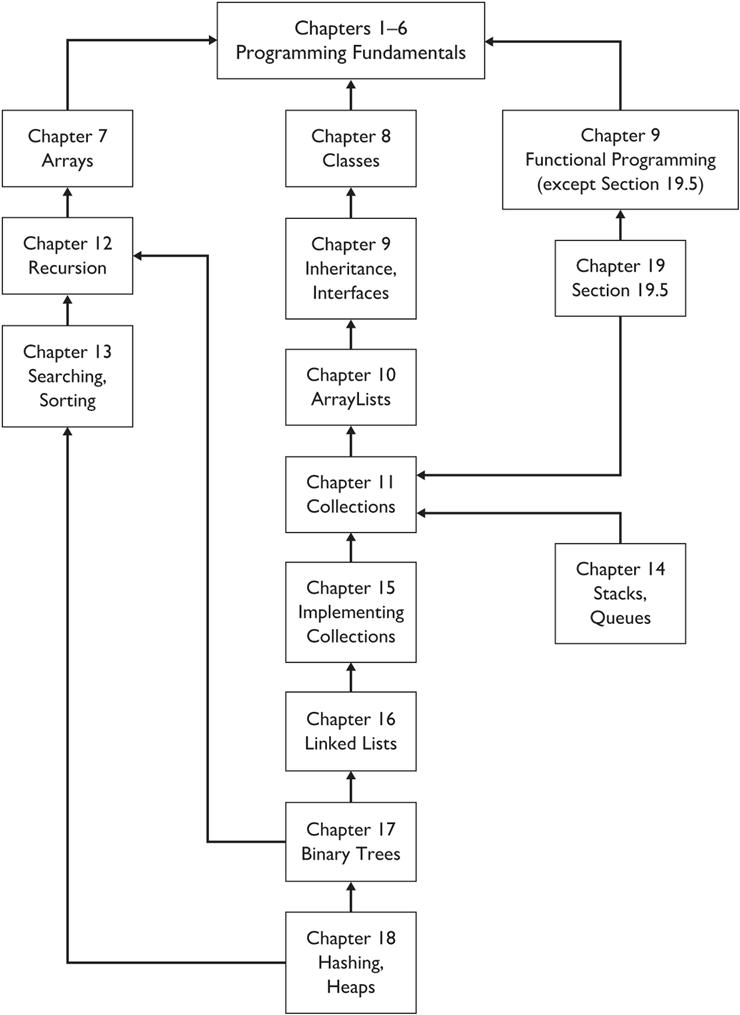A Back to Basics Approach
Fifth Edition
Stuart Reges
University of Washington
Marty Stepp
Stanford University
SVP, Courseware Portfolio Management: Marcia Horton
Portfolio Manager: Matt Goldstein
Portfolio Manager Assistant: Meghan Jacoby
VP, Product Marketing: Roxanne McCarley
Director of Field Marketing: Tim Galligan
Product Marketing Manager: Yvonne Vannatta
Field Marketing Manager: Demetrius Hall
Marketing Assistant: Jon Bryant
Managing Content Producer: Scott Disanno
VP, Production & Digital Studio: Ruth Berry
Project Manager: Lakeside Editorial Services L.L.C.
Senior Specialist, Program Planning and Support: Deidra Headlee
Cover Design: Jerilyn Bockorick
R&P Manager: Ben Ferrini
R&P Project Manager: Lav Kush Sharma/Integra Publishing Services, Inc.
Cover Art: Marcell Faber/Shutterstock
Full-Service Project Management: Integra Software Services Pvt. Ltd.
Composition: Integra Software Services Pvt. Ltd.
Printer/Binder: LSC Communications
Cover Printer: Phoenix Color
Text Font: Monotype
The authors and publisher of this book have used their best efforts in preparing this book. These efforts include the development, research, and testing of the theories and programs to determine their effectiveness. The authors and publisher make no warranty of any kind, expressed or implied, with regard to these programs or to the documentation contained in this book. The authors and publisher shall not be liable in any event for incidental or consequential damages in connection with, or arising out of, the furnishing, performance, or use of these programs.
Copyright © 2020, 2017, 2014 and 2011 Pearson Education, Inc. or its affiliates. All rights reserved. Printed in the United States of
America. This publication is protected by copyright, and permission should be obtained from the publisher prior to any prohibited reproduction, storage in a retrieval system, or transmission in any form or by any means, electronic, mechanical, photocopying, recording, or otherwise. For information regarding permissions, request forms and the appropriate contacts within the Pearson Education Global Rights & Permissions department, please visit www.pearsonhighed.com/permissions/.
PEARSON, and MyLab Programming are exclusive trademarks in the U.S. and/or other countries owned by Pearson Education, Inc. or its affiliates.
Unless otherwise indicated herein, any third-party trademarks that may appear in this work are the property of their respective owners and any references to third-party trademarks, logos or other trade dress are for demonstrative or descriptive purposes only. Such references are not intended to imply any sponsorship, endorsement, authorization, or promotion of Pearson's products by the owners of such marks, or any relationship between the owner and Pearson Education, Inc. or its affiliates, authors, licensees or distributors.
Library of Congress Cataloging-in-Publication Data
Names: Reges, Stuart, author. | Stepp, Martin, author.
Title: Building Java programs: a back to basics approach / Stuart Reges, University of Washington, Marty Stepp, Stanford University.
Description: Fifth edition. | Hoboken, New Jersey: Pearson, 2019. | Includes index.
Identifiers: LCCN 2018050748 | ISBN 9780135471944 | ISBN 013547194X
Subjects: LCSH: Java (Computer program language)
Classification: LCC QA76.73.J38 R447 2019 | DDC 005.13/3—dc23
LC record available at https://lccn.loc.gov/2018050748
1 19
ISBN 10: 0-13-547194-X
ISBN 13: 978-0-13-547194- 4
Preface
The newly revised fifth edition of our Building Java Programs textbook is designed for use in a two-course introduction to computer science. We have class-tested it with thousands of undergraduates, most of whom were not computer science majors, in our CS1-CS2 sequence at the University of Washington. These courses are experiencing record enrollments, and other schools that have adopted our textbook report that students are succeeding with our approach.
Introductory computer science courses are often seen as “killer” courses with high failure rates. But as Douglas Adams says in The Hitchhiker’s Guide to the Galaxy, “Don’t panic.” Students can master this material if they can learn it gradually. Our textbook uses a layered approach to introduce new syntax and concepts over multiple chapters.
Our textbook uses an “objects later” approach where programming fundamentals and procedural decomposition are taught before diving into object-oriented programming. We have championed this approach, which we sometimes call “back to basics,” and have seen through years of experience that a broad range of scientists, engineers, and others can learn how to program in a procedural manner. Once we have built a solid foundation of procedural techniques, we turn to object-oriented programming. By the end of
the course, students will have learned about both styles of programming.
The Java language is always evolving, and we have made it a point of focus in recent editions on newer features that have been added in Java 8 through 10. In the fourth edition we added a new Chapter 19 on Java’s functional programming features introduced in Java 8. In this edition we integrate the JShell tool introduced in Java 9.
New to This Edition
The following are the major changes for our fifth edition:
JShell integration. Java 9 introduced JShell, a utility with an interactive read-eval-print loop (REPL) that makes it easy to type Java expressions and immediately see their results. We find JShell to be a valuable learning tool that allows students to explore Java concepts without the overhead of creating a complete program. We introduce JShell in Chapter 2 and integrate JShell examples in each chapter throughout the text. Improved Chapter 2 loop coverage. We have added new sections and figures in Chapter 2 to help students understand for loops and create tables to find patterns in nested loops. This new content is based on our interactions with our own students as they solve programming problems with loops early in our courses.
Revamped case studies, examples, and other content. We have rewritten or revised sections of various chapters based on student and instructor feedback. We have also rewritten the Chapter 10 (ArrayLists) case study with a new program focusing on elections and ranked choice voting. Updated collection syntax and idioms. Recent releases of Java have introduced new syntax and features related to collections, such as the <> “diamond operator;” collection interfaces such as Lists , Sets , and Maps ; and new collection methods. We have updated our collection Chapters 10 and 11 to discuss these new features, and we use the diamond operator syntax with collections in the rest of the text. Expanded self-checks and programming exercises. With each new edition we add new programming exercises to the end of each chapter. There are roughly fifty total problems and exercises per chapter, all of which have been class-tested with real students and have solutions provided for instructors on our web site.
New programming projects. Some chapters have received new programming projects, such as the Chapter 10 ranked choice ballot project.
Features from Prior Editions
The following features have been retained from previous editions:
Focus on problem solving. Many textbooks focus on language details when they introduce new constructs. We focus instead on problem solving. What new problems can be solved with each construct? What pitfalls are novices likely to encounter along the way? What are the most common ways to use a new construct? Emphasis on algorithmic thinking. Our procedural approach allows us to emphasize algorithmic problem solving: breaking a large problem into smaller problems, using pseudocode to refine an algorithm, and grappling with the challenge of expressing a large program algorithmically.
Layered approach. Programming in Java involves many concepts that are difficult to learn all at once. Teaching Java to a novice is like trying to build a house of cards. Each new card has to be placed carefully. If the process is rushed and you try to place too many cards at once, the entire structure collapses. We teach new concepts gradually, layer by layer, allowing students to expand their understanding at a manageable pace.
Case studies. We end most chapters with a significant case study that shows students how to develop a complex program in stages and how to test it as it is being developed. This structure allows us to demonstrate each new programming construct in a rich context that can’t be achieved with short code examples. Several of the case studies were expanded and improved in the second edition.
Utility as a CS1+CS2 textbook. In recent editions, we added chapters that extend the coverage of the book to cover all of the topics from our second course in computer science, making the book usable for a two-course sequence. Chapters 12 –19
explore recursion, searching and sorting, stacks and queues, collection implementation, linked lists, binary trees, hash tables, heaps, and more. Chapter 12 also received a section on recursive backtracking, a powerful technique for exploring a set of possibilities for solving problems such as 8 Queens and Sudoku.
This year also marks the release of our new Building Python Programs textbook, which brings our “back to basics” approach to the Python language. In recent years Python has seen a surge in popularity in introductory computer science classrooms. We have found that our materials and approach work as well in Python as they do in Java, and we are pleased to offer the choice of two languages to instructors and students.
Layers and Dependencies
Many introductory computer science books are language-oriented, but the early chapters of our book are layered. For example, Java has many control structures (including for-loops, while-loops, and if/else-statements), and many books include all of these control structures in a single chapter. While that might make sense to someone who already knows how to program, it can be overwhelming for a novice who is learning how to program. We find that it is much more effective to spread these control structures into different chapters so that students learn one structure at a time rather than trying to learn them all at once.
The following table shows how the layered approach works in the first six chapters:
Chapters 1 –6 are designed to be worked through in order, with greater flexibility of study then beginning in Chapter 7 . Chapter 6 may be skipped, although the case study in Chapter 7 involves reading from a file, a topic that is covered in Chapter 6 .
The following is a dependency chart for the book:
Supplements
http://www.buildingjavaprograms.com/
Answers to all self-check problems appear on our web site and are accessible to anyone. Our web site has the following additional resources for students:
Online-only supplemental chapters, such as a chapter on creating Graphical User Interfaces
Source code and data files for all case studies and other complete program examples
The DrawingPanel class used in the optional graphics Supplement 3G
Our web site has the following additional resources for teachers:
PowerPoint slides suitable for lectures
Solutions to exercises and programming projects, along with homework specification documents for many projects
Sample exams and solution keys
Additional lab exercises and programming exercises with solution keys
Closed lab creation tools to produce lab handouts with the instructor's choice of problems integrated with the textbook
To access instructor resources, contact us at authors@buildingjavaprograms.com. The same materials are also available at http://www.pearsonhighered.com/cs-resources. To ask other questions related to resources, contact your Pearson sales representative.
MyLab Programming
MyLab Programming is an online practice and assessment tool that helps students fully grasp the logic, semantics, and syntax of programming. Through practice exercises and immediate, personalized feedback, MyLab Programming improves the programming competence of beginning students who often struggle with basic concepts and paradigms of popular high-level programming languages. A self-study and homework tool, the MyLab Programming course consists of hundreds of small practice
exercises organized around the structure of this textbook. For students, the system automatically detects errors in the logic and syntax of code submissions and offers targeted hints that enable students to figure out what went wrong, and why. For instructors, a comprehensive grade book tracks correct and incorrect answers and stores the code inputted by students for review.
For a full demonstration, to see feedback from instructors and students, or to adopt MyLab Programming for your course, visit the following web site: www.pearson.com/mylab/programming
VideoNotes
We have recorded a series of instructional videos to accompany the textbook. They are available at the following web site: http://www.pearsonhighered.com/cs-resources
Roughly 3–4 videos are posted for each chapter. An icon in the margin of the page indicates when a VideoNote is available for a
given topic. In each video, we spend 5–15 minutes walking through a particular concept or problem, talking about the challenges and methods necessary to solve it. These videos make a good supplement to the instruction given in lecture classes and in the textbook. Your new copy of the textbook has an access code that will allow you to view the videos.
Acknowledgments
First, we would like to thank the many colleagues, students, and teaching assistants who have used and commented on early drafts of this text. We could not have written this book without their input. Special thanks go to Hélène Martin, who pored over early versions of our first edition chapters to find errors and to identify rough patches that needed work. We would also like to thank instructor Benson Limketkai for spending many hours performing a technical proofread of the second edition.
Second, we would like to thank the talented pool of reviewers who guided us in the process of creating this textbook:
Greg Anderson, Weber State University
Delroy A. Brinkerhoff, Weber State University
Ed Brunjes, Miramar Community College
Tom Capaul, Eastern Washington University
Tom Cortina, Carnegie Mellon University
Charles Dierbach, Towson University
H.E. Dunsmore, Purdue University
Michael Eckmann, Skidmore College
Mary Anne Egan, Siena College
Leonard J. Garrett, Temple University
Ahmad Ghafarian, North Georgia College & State University
Raj Gill, Anne Arundel Community College
Michael Hostetler, Park University
David Hovemeyer, York College of Pennsylvania
Chenglie Hu, Carroll College
Philip Isenhour, Virginia Polytechnic Institute
Andree Jacobson, University of New Mexico
David C. Kamper, Sr., Northeastern Illinois University
Simon G.M. Koo, University of San Diego
Evan Korth, New York University
Joan Krone, Denison University
John H.E.F. Lasseter, Fairfield University
Eric Matson, Wright State University
Kathryn S. McKinley, University of Texas, Austin
Jerry Mead, Bucknell University
George Medelinskas, Northern Essex Community College
John Neitzke, Truman State University
Dale E. Parson, Kutztown University
Richard E. Pattis, Carnegie Mellon University
Frederick Pratter, Eastern Oregon University
Roger Priebe, University of Texas, Austin
Dehu Qi, Lamar University
John Rager, Amherst College
Amala V.S. Rajan, Middlesex University
Craig Reinhart, California Lutheran University
Mike Scott, University of Texas, Austin
Alexa Sharp, Oberlin College
Tom Stokke, University of North Dakota
Leigh Ann Sudol, Fox Lane High School
Ronald F. Taylor, Wright State University
Andy Ray Terrel, University of Chicago
Scott Thede, DePauw University
Megan Thomas, California State University, Stanislaus
Dwight Tuinstra, SUNY Potsdam
Jeannie Turner, Sayre School
Tammy VanDeGrift, University of Portland
Thomas John VanDrunen, Wheaton College
Neal R. Wagner, University of Texas, San Antonio
Jiangping Wang, Webster University
Yang Wang, Missouri State University
Stephen Weiss, University of North Carolina at Chapel Hill
Laurie Werner, Miami University
Dianna Xu, Bryn Mawr College
Carol Zander, University of Washington, Bothell
Finally, we would like to thank the great staff at Pearson who helped produce the book. Michelle Brown, Jeff Holcomb, Maurene Goo, Patty Mahtani, Nancy Kotary, and Kathleen Kenny did great work preparing the first edition. Our copy editors and the staff of Aptara Corp, including Heather Sisan, Brian Baker, Brendan Short, and Rachel Head, caught many errors and improved the quality of the writing. Marilyn Lloyd and Chelsea Bell served well as project
manager and editorial assistant respectively on prior editions. For their help with the third edition we would like to thank Kayla SmithTarbox, Production Project Manager, and Jenah Blitz-Stoehr, Computer Science Editorial Assistant. Mohinder Singh and the staff at Aptara, Inc., were also very helpful in the final production of the third edition. For their great work on production of the fourth and fifth editions, we thank Louise Capulli and the staff of Lakeside Editorial Services, along with Carole Snyder at Pearson. Special thanks go to our lead editor at Pearson, Matt Goldstein, who has believed in the concept of our book from day one. We couldn’t have finished this job without all of their hard work and support.
Stuart Reges Marty Stepp
Text
http://www.pearson.com/cs-resources
Chapter 1 Pages 31, 40
Chapter 2 Pages 65, 76, 92, 100, 115
Chapter 3 Pages 146, 161, 166, 173, 178
Chapter 3G Pages 202, 220
Chapter 4 Pages 248, 256, 283
Chapter 5 Pages 329, 333, 337, 339, 362
Chapter 6 Pages 401, 413, 427
Chapter 7 Pages 464, 470, 488, 510
Chapter 8 Pages 540, 552, 560, 573
Chapter 9 Pages 602, 615, 631
Chapter 10 Pages 679, 686, 694
Chapter 11 Pages 723, 737, 745
Chapter 12 Pages 773, 781, 818
Chapter 13 Pages 842, 845, 852
Chapter 14 Pages 897, 904
Chapter 15 Pages 939, 945, 949
Chapter 16 Pages 982, 989, 1002
Chapter 17 Pages 1048, 1049, 1059
Chapter 18 Pages 1085, 1104
Brief Contents
Chapter 1 Introduction to Java Programming 1
Chapter 2 Primitive Data and Definite Loops 63
Chapter 3 Introduction to Parameters and Objects 142
Supplement 3G Graphics (Optional) 201
Chapter 4 Conditional Execution 243
Chapter 5 Program Logic and Indefinite Loops 320
Chapter 6 File Processing 392
Chapter 7 Arrays 447
Chapter 8 Classes 535
Chapter 9 Inheritance and Interfaces 592
Chapter 10 ArrayLists 667
Chapter 11 Java Collections Framework 722
Chapter 12 Recursion 763
Chapter 13 Searching and Sorting 840
Chapter 14 Stacks and Queues 892
Chapter 15 Implementing a Collection Class 931
Chapter 16 Linked Lists 975
Chapter 17 Binary Trees 1028
Chapter 18 Advanced Data Structures 1083
Chapter 19 Functional Programming with Java 8 1119
Appendix A Java Summary 1161
Appendix B The Java API Specification and Javadoc Comments 1176
Appendix C Additional Java Syntax 1182
Index 1191
Chapter 1 Introduction to Java Programming 1
1.1 Basic Computing Concepts 2
Why Programming? 2
Hardware and Software 3
The Digital Realm 4
The Process of Programming 6
Why Java? 7
The Java Programming Environment 8
1.2 And Now—Java 10
String Literals (Strings) 14
System.out.println 15
Escape Sequences 15
print versus println 17
Identifiers and Keywords 18
A Complex Example: DrawFigures1 20
Comments and Readability 21
1.3 Program Errors 24
Syntax Errors 24
Logic Errors (Bugs) 28
1.4 Procedural Decomposition 28
Static Methods 31
Flow of Control 34
Methods That Call Other Methods 36
An Example Runtime Error 39
1.5 Case Study: DrawFigures 40
Structured Version 41
Final Version without Redundancy 43
Analysis of Flow of Execution 44
Chapter 2 Primitive Data and Definite Loops 63
2.1 Basic Data Concepts 64
Primitive Types 64
Expressions 65
JShell 67
Literals 68
Arithmetic Operators 69
Precedence 72
Mixing Types and Casting 74
2.2 Variables 76
Assignment/Declaration Variations 81
String Concatenation 84
Increment/Decrement Operators 87
Variables and Mixing Types 90
2.3 The for Loop 92
Tracing for Loops 94 for Loop Patterns 98
Nested for Loops 100
2.4 Managing Complexity 103
Scope 103
Pseudocode 108
The Table Technique 110
Class Constants 113
2.5 Case Study: Hourglass Figure 115
Problem Decomposition and Pseudocode 115
Initial Structured Version 117
Adding a Class Constant 119
Further Variations 122
Chapter 3 Introduction to Parameters and Objects 142
3.1 Parameters 143
The Mechanics of Parameters 146
Limitations of Parameters 150
Multiple Parameters 153
Parameters versus Constants 156
Overloading of Methods 156
3.2 Methods That Return Values 157
The Math Class 158
Defining Methods That Return Values 161
3.3 Using Objects 165
String Objects 166
Interactive Programs and Scanner Objects 173
Sample Interactive Program 176
3.4 Case Study: Projectile Trajectory 178
Unstructured Solution 182
Structured Solution 184
Supplement 3G Graphics (Optional) 201
